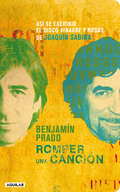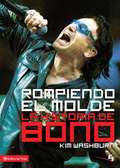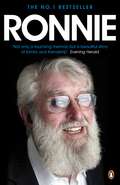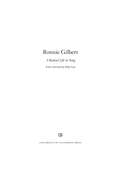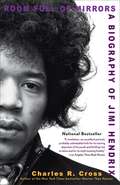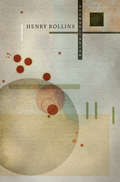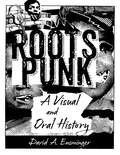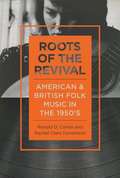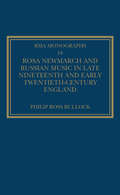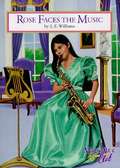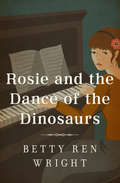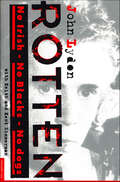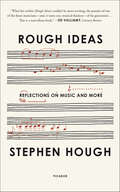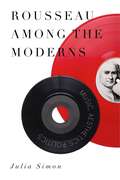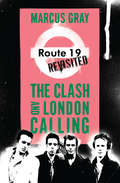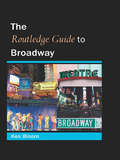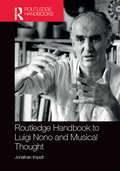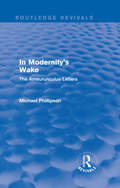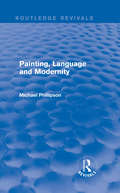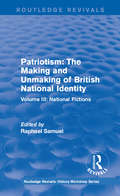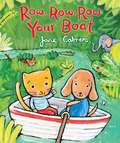- Table View
- List View
Romper una canción: Así se escribió el disco Vinagre y rosas, de Joaquín Sabina
by Benjamín PradoUn día, a principios del año 2009, Joaquín Sabina y Benjamín Prado decidieron irse a Praga a escribir canciones y siete meses después habían acabado el disco Vinagre y rosas. Este libro cuenta esa aventura que fue puro rock and roll, llena de versos y versos tachados, chicas que vienen y que se van, viajes, música, alcohol, risas y, sobre todo, lleno de una amistad sin fronteras ni direcciones prohibidas. Y también nos deja ver los talleres de cada canción y nos hipnotiza haciéndonos mirar las vueltas que dieron todas ellas antes de quedar acabadas. Benjamín Prado rememora en Romper una canción la intensidad de aquellos meses de trabajo en los que Sabina y él pelearon a muerte por cada palabra y llegaron a lograr una combustión y una simbiosis tan profundas que hoy día ninguno de ellos sabe quién escribió qué, porque no hay una coma sin negociar en todo el disco. Así se escribió Vinagre y rosas.
Rompiendo el molde, la historia de Bono
by Kim WashburnLA HISTORIA DE UN MUCHACHO DE DUBLÍN QUE SE CONVIRTIÓ EN UNA DE LAS MAYORES ESTRELLAS DE ROCK DEL PLANETA Y NO SE CONFORMÓ CON SER SOLAMENTE UN CANTANTE Premios, fama, riquezas… ¡Bono pareciera tenerlo todo! Pero la mayor estrella de rock del mundo confiesa tener algo todavía más importante que ha guiado cada uno de sus pasos hacia el éxito: la fe en Dios. Desde su crianza en Irlanda en tiempos realmente peligrosos, hasta tocar en los mayores escenarios del mundo, las creencias de Bono lo han mantenido arraigado y enfocado en lo que verdaderamente importa. Ya sea usando su voz para cautivar a la audiencia o luchando por la justicia y la salud en África, el mundo sabe que además de cantar, Bono es un defensor de los perdidos y un héroe para los que pelean por un mundo más justo.
Ronnie
by Ronnie DrewThe late great Dubliner, Ronnie Drew, was six months into writing his biography when he was diagnosed with cancer. He had produced warm, witty and insightful material that made it clear that he was a wonderful writer as well as a great singer and storyteller. With the encouragement of his wife Deirdre and his family, he continued to think about the book and conducted a number of interviews to keep things ticking over until he was well enough to resume work on it. But sadly, much as he wanted to, Ronnie did not get to finish his story.However, with the whole-hearted co-operation of his daughter and son, Cliodhna and Phelim, it has been possible to put together Ronnie's work on his memoir along with his other writings, interviews with Cliodhna and Phelim, a wealth of photographs and other material from the family archive, and contributions from close friends, to create a book that is a wonderful portrait of, and a fitting and loving tribute to, the man Bono called 'the king of Ireland'.
Ronnie Gilbert
by Ronnie GilbertRonnie Gilbert had a long and colorful career as a singer, actor, playwright, therapist, and independent woman. Her lifelong work for political and social change was central to her role as a performer. Raised in Depression-era New York City by leftist, working-class, secular Jewish parents, Gilbert is best known as a member of the Weavers, the quartet of the 1950s and '60s that survived the blacklist and helped popularize folk music in America. Her joyous contralto and vibrant stage presence enriched the celebrated group and propelled Gilbert into a second singing career with Holly Near in the 1980s and '90s. As an actor, Gilbert explored developmental theater with Joseph Chaikin and Peter Brook and wrote and performed in ensemble and solo productions across the United States and Canada.Ronnie Gilbert brings the political, artistic, and social issues of the era alive through song lyrics and personal stories, traversing sixty years of collaborations in life and art that span the folk revival, the Cold War blacklist, primal therapy, the back-to-the-land movement, and a rich, multigenerational family story. Much more than a memoir, Ronnie Gilbert is a unique and engaging historical document for readers interested in music, theater, American politics, the women's movement, and left-wing activism.
Room Full of Mirrors: A Biography of Jimi Hendrix
by Charles R. CrossNow in paperback, the national bestselling biography of American musical icon Jimi HendrixIt has been more than thirty-five years since Jimi Hendrix died, but his music and spirit are still very much alive for his fans everywhere. Charles R. Cross vividly recounts the life of Hendrix, from his difficult childhood and adolescence in Seattle through his incredible rise to celebrity in London's swinging sixties. It is the story of an outrageous life--with legendary tales of sex, drugs, and excess--while it also reveals a man who struggled to accept his role as idol and who privately craved the kind of normal family life he never had. Using never-before-seen documents and private letters, and based on hundreds of interviews with those who knew Hendrix--many of whom had never before agreed to be interviewed--Room Full of Mirrors unlocks the vast mystery of one of music's most enduring legends.
Roomanitarian
by Henry RollinsIn Roomanitarian, popular author, actor, musician, and spoken-word artist Henry Rollins returns to the combative prose that has won him critical acclaim and a legion of devoted fans. The book is divided into three parts: The first section, "Walking the Chasm," written in the form of a poem, epitomizes Rollins's beautifully stark, hard-hitting style. The second part, "Ended," is a series of short prose pieces reminiscent of Solipsist. Finally, the biting humor and social commentary Rollins is renowned for is on full display in "To Ann Hitler with Love," a series of mock love letters to a fictional woman who bears a striking resemblance to conservative pundit Ann Coulter.
Roots Punk: A Visual and Oral History (American Made Music Series)
by David A. EnsmingerPunk rock evokes dissent and disruption, abrasive and anarchic musicality, and a host of countercultural aesthetics. Featuring original interviews and over one hundred images, Roots Punk: A Visual and Oral History by longtime music journalist and author David A. Ensminger focuses on how punk merged with roots music to create a rich style that incorporated honky-tonk, rockabilly, doo-wop, reggae, ska, jazz, folk, blues, and labor ballads. This engagement transformed the notion of punk to include a wide array of vintage source material that seems more aligned with bolo ties and Stetsons than Doc Martens and safety pins. Ensminger explores the music’s aesthetics, traits, and themes. He contextualizes, clarifies, maps, and probes roots punk’s hybrid nature as well as its diverse, queer-inclusive, and multicultural strains. By painting a broad, nuanced, and well-documented picture of the genre from its earliest incarnation, he forms a kind of people’s history of the movement. Roots Punk features original interviews with members of Minutemen, MDC, the Dicks, the Plimsouls, Tex and the Horseheads, Dils/Rank and File, X, the Flesh Eaters, Beatnigs, Alejandro Escovedo, Robert “El Vez” Lopez, Blasters, and more. Whether covering sarcastic novelty forms or sincere embraces, Ensminger reveals and revels in a punk tradition lined with blues records, acoustic ballads, country, and hillbilly romp. In a time of growing conformity, replication, and commercialization, roots punk (sometimes dubbed cow-punk) offers a tantalizing revitalization and reimagination of the American songbook.
Roots and Rhythm: A Life in Music
by Charlie PeacockA beautifully crafted memoir unveiling the ancestral, musical, and spiritual roots of Grammy Award-winning music producer Charlie Peacock. In this artful memoir, Grammy Award–winning music producer Charlie Peacock flexes his literary chops and gives readers the gritty backstage stories they crave: biographical anecdotes, geeky trivia, and how the hits were written and recorded (from jazz to rock and pop). Threaded throughout is Peacock&’s unique ancestral and spiritual story—the roots. Like Coltrane, Dylan, and Bono before him, Peacock reveals a Christ-affection while refusing genres too small for his music. Peacock, the great-grandson of a Louisiana fiddler, is an American musical polymath. He&’s been the young jazz musician sitting at the feet of trumpeter Eddie Henderson and pianist Herbie Hancock; the singer-songwriter plucked from the Northern California punk/pop underground by legendary impresarios Bill Graham and Chris Blackwell; a pioneering, innovative contributor to the nascent rise of gospel rock in the 1980s; and the genre-busting producer behind such diverse artists as Al Green, Ladysmith Black Mambazo, Chris Cornell, Audio Adrenaline, The Civil Wars, Switchfoot, Turtle Island Quartet, and John Patitucci.Roots and Rhythm includes Peacock&’s seminal NorCal days, the story of indie labels Exit and re:think, his first decade as a Nashville producer (1989–1999), and his essential role in the 21st-century folk/Americana boom (The Civil Wars, Holly Williams, The Lone Bellow). While his exploits and achievements grace the book (including the story of Amy Grant&’s &“Every Heartbeat&” and the evergreen &“In the Light&”), Peacock is hardly the only character. Instead, he writes as a Joan Didion-style essayist, weaving together a quintessential American story. Beat poet Gary Snyder, evangelist Billy Graham, producer T Bone Burnett, saxophonist Wayne Shorter, and writers Wendell Berry and Isabel Wilkerson all appear in this sweeping tale where ancestry, migration, teenage love, Jesus, and Miles Davis collide. The book is an invitation to all, including aspiring musicians: embrace the roots and rhythm of our own lives, letting the music and God&’s insistent love lead us to gratitude and wonder.
Roots of the Revival: American and British Folk Music in the 1950s (Music in American Life)
by Ronald D Cohen Rachel Clare DonaldsonIn Roots of the Revival: American and British Folk Music in the 1950s, Ronald D. Cohen and Rachel Clare Donaldson present a transatlantic history of folk's midcentury resurgence that juxtaposes the related but distinct revivals that took place in the United States and Great Britain. After setting the stage with the work of music collectors in the nineteenth century, the authors explore the so-called recovery of folk music practices and performers by Alan Lomax and others, including journeys to and within the British Isles that allowed artists and folk music advocates to absorb native forms and facilitate the music's transatlantic exchange. Cohen and Donaldson place the musical and cultural connections of the twin revivals within the decade's social and musical milieu and grapple with the performers' leftist political agendas and artistic challenges, including the fierce debates over "authenticity" in practice and repertoire that erupted when artists like Harry Belafonte and the Kingston Trio carried folk into the popular music mainstream. From work songs to skiffle, from the Weavers in Greenwich Village to Burl Ives on the BBC, Roots of the Revival offers a frank and wide-ranging consideration of a time, a movement, and a transformative period in American and British pop culture.
Rosa Newmarch and Russian Music in Late Nineteenth and Early Twentieth-Century England (Royal Musical Association Monographs #18)
by PhilipRoss BullockPhilip Ross Bullock looks at the life and works of Rosa Newmarch (1857-1940), the leading authority on Russian music and culture in late nineteenth- and early twentieth-century England. Although Newmarch's work and influence are often acknowledged - most particularly by scholars of English poetry, and of the role of women in English music - the full range of her ideas and activities has yet to be studied. As an inveterate traveller, prolific author, and polyglot friend of some of Europe's leading musicians, such as Elgar, Sibelius and Jan�k, Newmarch deserves to be better appreciated. On the basis of both published and archival materials, the details of Newmarch's busy life are traced in an opening chapter, followed by an overview of English interest in Russian culture around the turn of the century, a period which saw a long-standing Russophobia (largely political and military) challenged by a more passionate and well-informed interest in the arts Three chapters then deal with the features that characterize Newmarch's engagement with Russian culture and society, and - more significantly perhaps - which she also championed in her native England; nationalism; the role of the intelligentsia; and feminism. In each case, Newmarch's interest in Russia was no mere instance of ethnographic curiosity; rather, her observations about and passion for Russia were translated into a commentary on the state of contemporary English cultural and social life. Her interest in nationalism was based on the conviction that each country deserved an art of its own. Her call for artists and intellectuals to play a vital role in the cultural and social life of the country illustrated how her Russian experiences could map onto the liberal values of Victorian England. And her feminism was linked to the idea that women could exercise roles of authority and influence in society through participation in the arts. A final chapter considers how her late interest in the music of Czechoslovakia pi
Rose Faces the Music (Magic Attic Club)
by L. E. WilliamsOn another adventure through the mirror in the magic attic, Rose finds herself chosen to play a saxophone solo in a jazz performance at the presidential inaugural celebration.
Rosie and the Dance of the Dinosaurs
by Betty Ren WrightThe big piano recital is coming up soon, and Rosie feels anything but ready—&“captures the down-to-earth rhythms of suburban life, spiced with humor&” (Kirkus Reviews). Even though Rosie has only nine fingers, she&’s always managed well. Until now. For some reason, she can&’t master the piano solo she&’s been rehearsing for the annual recital. It&’s called &“The Dance of the Dinosaurs,&” and it&’s hard! As the recital draws near, Rosie is desperate. Why does everything seem so much more difficult now? Is it because she misses her father? Since he moved to Milwaukee to take a new job, Rosie&’s been miserable, and her mother has been acting kind of strange. Or is Rosie having trouble because she&’s worried about the burglar who&’s been secretly visiting her house? Then, too, there&’s Mary Jean, the new girl in town. Not only is she rich and pretty, but she plays the piano beautifully. In the weeks before the recital, Rosie fights some hard battles. To her surprise, she discovers that having nine fingers isn&’t such a bad thing after all.
Rotten: No Irish, No Blacks, No Dogs
by Keith Zimmerman Kent Zimmerman John Lydon"I have no time for lies and fantasy, and neither should you. Enjoy or die..." --John LydonPunk has been romanticized and embalmed in various media. An English class revolt that became a worldwide fashion statement, punk's idols were the Sex Pistols, and its sneering hero was Johnny Rotten.Seventeen years later, John Lydon looks back at himself, the Sex Pistols, and the "no future" disaffection of the time. Much more than just a music book, Rotten is an oral history of punk: angry, witty, honest, poignant, crackling with energy. Malcolm McLaren, Sid Vicious, Chrissie Hynde, Billy Idol, London and England in the late 1970s, the Pistols' creation and collapse...all are here, in perhaps the best book ever written about music and youth culture, by one of its most notorious figures.
Rough Ideas: Reflections on Music and More
by Stephen HoughA collection of essays on music and life by the famed classical pianist and composerStephen Hough is one of the world’s leading pianists, winning global acclaim and numerous awards, both for his concerts and his recordings. He is also a writer, composer, and painter, and has been described by The Economist as one of “Twenty Living Polymaths.”Hough writes informally and engagingly about music and the life of a musician, from the broader aspects of what it is to walk out onto a stage or to make a recording, to specialist tips from deep inside the practice room: how to trill, how to pedal, how to practice. He also writes vividly about people he’s known, places he’s traveled to, books he’s read, paintings he’s seen; and he touches on more controversial subjects, such as assisted suicide and abortion. Even religion is there—the possibility of the existence of God, problems with some biblical texts, and the challenges involved in being a gay Catholic.Rough Ideas is an illuminating, constantly surprising introduction to the life and mind of one of our great cultural figures.
Rounding Wagner's Mountain
by Bryan GilliamRichard Strauss' fifteen operas, which span the years 1893 to 1941, make up the largest German operatic legacy since Wagner's operas of the nineteenth century. Many of Strauss's works were based on texts by Europe's finest writers: Oscar Wilde, Hugo von Hofmannsthal and Stefan Zweig, among others, and they also overlap some of the most important and tumultuous stretches of German history, such as the founding and demise of a German empire, the rise and fall of the Weimar Republic, the period of National Socialism, and the post-war years, which saw a divided East and West Germany. In the first book to discuss all Strauss's operas, Bryan Gilliam sets each work in its historical, aesthetic, philosophical, and literary context to reveal what made the composer's legacy unique. Addressing Wagner's cultural influence upon this legacy, Gilliam also offers new insights into the thematic and harmonic features that recur in Strauss's compositions.
Rousseau Among the Moderns: Music, Aesthetics, Politics
by Julia SimonRenowned for his influence as a political philosopher, a writer, and an autobiographer, Jean-Jacques Rousseau is known also for his lifelong interest in music. He composed operas and other musical pieces, invented a system of numbered musical notation, engaged in public debates about music, and wrote at length about musical theory. Critical analysis of Rousseau’s work in music has been principally the domain of musicologists, rarely involving the work of scholars of political theory or literary studies. In Rousseau Among the Moderns, Julia Simon puts forth fresh interpretations of The Social Contract, the Discourse on the Origin of Inequality, and the Confessions, as well as other texts. She links Rousseau’s understanding of key concepts in music, such as tuning, harmony, melody, and form, to the crucial problem of the individual’s relationship to the social order. The choice of music as the privileged aesthetic object enables Rousseau to gain insight into the role of the aesthetic realm in relation to the social and political body in ways often associated with later thinkers. Simon argues that much of Rousseau’s “modernism” resides in the unique role that he assigns to music in forging communal relations.
Rousseau Among the Moderns: Music, Aesthetics, Politics
by Julia SimonRenowned for his influence as a political philosopher, a writer, and an autobiographer, Jean-Jacques Rousseau is known also for his lifelong interest in music. He composed operas and other musical pieces, invented a system of numbered musical notation, engaged in public debates about music, and wrote at length about musical theory. Critical analysis of Rousseau’s work in music has been principally the domain of musicologists, rarely involving the work of scholars of political theory or literary studies. In Rousseau Among the Moderns, Julia Simon puts forth fresh interpretations of The Social Contract, the Discourse on the Origin of Inequality, and the Confessions, as well as other texts. She links Rousseau’s understanding of key concepts in music, such as tuning, harmony, melody, and form, to the crucial problem of the individual’s relationship to the social order. The choice of music as the privileged aesthetic object enables Rousseau to gain insight into the role of the aesthetic realm in relation to the social and political body in ways often associated with later thinkers. Simon argues that much of Rousseau’s “modernism” resides in the unique role that he assigns to music in forging communal relations.
Route 19 Revisited: The Clash and London Calling
by Marcus GrayTwenty-eight years after its original release, The Clash's London Calling was inducted into the Grammy Hall of Fame as a "recording of lasting qualitative or historical significance." It topped polls on both sides of the Atlantic for the best album of the seventies (and eighties) and in publications as wide-ranging as Rolling Stone, VIBE, Pitchfork, and NME, and it regularly hits the top ten on greatest-albums-of-all-time-lists. Even its cover-the instantly recognizable image of Paul Simonon smashing his bass guitar-has attained iconic status, inspiring countless imitations and even being voted the best rock 'n' roll photograph ever by Q magazine.Now the breakthrough album from the foremost band of the punk era gets the close critical eye it deserves. Marcus Gray examines London Calling from every vantage imaginable, from the recording sessions and the state of the world it was recorded in to the album's long afterlife, bringing new levels of understanding to one of punk rock's greatest achievements. Leaving no detail unexplored, he provides a song-by-song breakdown covering when each was written and where, what inspired each song, and what in turn each song inspired, making this book a must-read for Clash fans.
Routledge Guide to Broadway
by Ken BloomThe Routledge Guide to Broadway is the second title in our new student reference series. It will introduce the student to the Broadway theater, focusing on key performers, writers, directors, plays, and musicals, along with the theaters themselves, key awards, and the folklore of Broadway.Broadway is the center of American theater, where all the great plays and musicals make their mark. Students across the country in theater history, performance, and direction/production look to Broadway for their inspiration. While there are illustrated coffee table type books on Broadway, there are few that offer a comprehensive look at the key figures and productions of the last two centuries. The Routledge Guide to Broadway offers this information in an easy-to-use, inexpensive format that will appeal to students, professors, and theatrical professionals.
Routledge Handbook of Asian Music: Cultural Intersections
by Lee Tong SoonThe Routledge Handbook of Asian Music: Cultural Intersections introduces Asian music as a way to ask questions about what happens when cultures converge and how readers may evaluate cultural junctures through expressive forms. The volume’s thirteen original chapters cover musical practices in historical and modern contexts from Central Asia, East Asia, South Asia, and Southeast Asia, including art music traditions, folk music and composition, religious and ritual music, as well as popular music. These chapters showcase the diversity of Asian music, requiring readers to constantly reconsider their understanding of this vibrant and complex area. The book is divided into three sections: Locating meanings Boundaries and difference Cultural flows Contributors to the book offer a multidisciplinary portfolio of methods, ranging from archival research and field ethnography to biographical studies and music analysis. In addition to rich illustrations, numerous samples of notation and sheet music are featured as insightful study resources. Readers are invited to study individuals, music-makers, listeners, and viewers to learn about their concerns, their musical choices, and their lives through a combination of humanistic and social-scientific approaches. Demonstrating how transformative cultural differences can become in intercultural encounters, this book will appeal to students and scholars of musicology, ethnomusicology, and anthropology.
Routledge Handbook to Luigi Nono and Musical Thought (Routledge Music Handbooks)
by Jonathan ImpettOf the post-war, post-serialist generation of European composers, it was Luigi Nono who succeeded not only in identifying and addressing aesthetic and technical questions of his time, but in showing a way ahead to a new condition of music in the twenty-first century. His music has found a listenership beyond the ageing constituency of ‘contemporary music’. In Nono’s work, the audiences of sound art, improvisation, electronic, experimental and radical musics of many kinds find common cause with those concerned with the renewal of Western art music. His work explores the individually and socially transformative role of music; its relationship with history and with language; the nature of the musical work as distributed through text, time, technology and individuals; the nature and performativity of the act of composition; and, above all, the role and nature of listening as a cultural activity. In many respects his music anticipates the new technological state of culture of the twenty-first century while radically reconnecting with our past. His work is itself a case study in the evolution of musical activity and the musical object: from the period of an apparently stable place for art music in Western culture to its manifold new states in our century. Routledge Handbook to Luigi Nono and Musical Thought seeks to trace the evolution of Nono’s musical thought through detailed examination of the vast body of sketches, and to situate this narrative in its personal, cultural and political contexts.
Routledge Revivals (1989): The Ameurunculus Letters
by Michael PhillipsonFirst published in 1988, this book attempts to tackle the problem of how to write about art, culture, and the issues of postmodernism in a style appropriate to what is being claimed. The letters are written on art’s behalf to a range of institutions and individuals, and have as their recurring concern the relation between art, culture and representation — both art as representation and how art is represented to, and for, the surrounding culture. They explore the context and viability of art through a range of themes, including writing, the aestheticisation of everyday life, style, design pleasure, fragmentation, hyphenation, technology, and the museum — drawing on materials from the visual arts, music, literature, post-structuralism, contemporary criticism, philosophy, and sociology.
Routledge Revivals: Painting, Language and Modernity (1985)
by Michael PhillipsonFirst published in 1985, this book draws together the author’s artistic with analytical practices which had been developed over many years of sociological enquiry. It interprets a ‘work of art’ as a site on which a viewer or critic is invited to share in questioning celebration of the painting itself. The author reassesses modern painting’s relation to its own origins and to tradition in light of the emergence of ‘postmodern’ practice — exploring its engagement of fundamental questions about language and being. Also assessed is the relevance of the metaphors of writings and Reading to an understanding of painting and viewing practices — looking at painters’ writings as well as phenomenological and post-structuralist writers.
Routledge Revivals: Volume III: National Fictions (Routledge Revivals: History Workshop Series)
by Raphael SamuelFirst published in 1989, this is the third of three volumes exploring the changing notions of patriotism in British life from the thirteenth century to the late twentieth century and constitutes an attempt to come to terms with the power of the national idea through a historically informed critique. This volume studies some of the leading figures of national myth, such as Britannia and John Bull. One group of essays looks at the idea of distinctively national landscape and the ways in which it corresponds to notions of social order. A chapter on the poetry of Edmund Spenser explores metaphorical representations of Britain as a walled garden, and the idea of an enchanted national space is taken up in a series of essays on literature, theatre and cinema. An introductory piece charts some of the startling changes in the image of national character, from the seventeenth-century notion of the English as the most melancholy people in Europe, to the more uncertain and conflicting images of today.
Row, Row, Row Your Boat
by Jane CabreraJane Cabrera's signature bold hues and lively animal characters are a delight in this version of the well-loved children's song, with new lyrics that encourage young readers to sing along.
